Structural effects of alkali-metals on the B12 skeleton†
Abstract
After an exhaustive exploration of the potential energy surface of B12E− and B12E2 (E = Li–Cs) systems, it was found that for the anionic series, a cage-type and a quasi-planar structure (very similar to the naked B12 cluster) compete to be the putative global minimum. For neutral systems, competition arises between the quasi-planar cluster and a double-ring with the alkali-metals on the highest-symmetry axis. The chemical bonding analyses show that for the entire series, the interaction, predominantly electrostatic, is essentially indistinguishable regardless of the alkali-metal and insufficient for determining the isomeric preference. The isomerization energy decomposition analysis (IEDA) reveals that in the anions, the structural change in the lighter complexes is possible because of the relatively low energy required for the boron skeleton deformation, as opposed to the case of heavy metals. In the case of the neutral systems, the factor determining one isomer over the other corresponds to that of the energy deformation of the alkali-metal dimer.

- This article is part of the themed collection: Celebrating recent chemical science in Mexico


 Please wait while we load your content...
Please wait while we load your content...